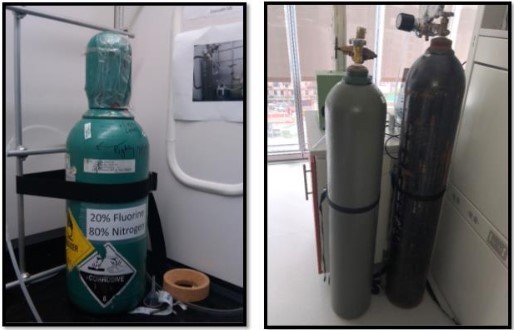Compressed Gas Safety Program
Any material or mixture which exerts an absolute pressure of 280 kPa (40.6 psia) or greater at 20°C in its packaging is called a “compressed gas”. The primary hazard associated with any compressed gas is the potential energy by virtue of the containers’ high pressure. Like chemicals, some compressed gases also exhibit other hazardous characteristics such as flammability, toxicity, corrosivity, reactivity, and cryogenic and associated asphyxiation hazards. The handling, storage and disposal of compressed gas cylinders at Columbia University is regulated by numerous agencies and standards, including: National Fire Protection Association (NFPA), Occupational Safety and Health Administration (OSHA), Environmental Protection Agency (EPA), US Department of Transporation (USDOT) and the New York City Fire Department (FDNY). The safe use and handling of compressed gases in research laboratories are the responsibilities of the principal investigator (PI) and their respective department, while researchers have the responsibility of utilizing appropriate administrative and engineering controls and assigned personal protective equipment (PPE).

In addition to the routine training already required of researchers, (see Training Finder) users of compressed gases at Columbia University are also required to complete the “Compressed Gas Safety Training” RASCAL course TC5450 before starting any relevant work.
EH&S has also developed a Compressed Gas Safety Manual to assist researchers to be able to understand and follow safety regulations while working with compressed gases. Highlights include the following attachments:
- Summary Table of Compressed Gas Hazards lists a number of commonly used hazardous compressed gases at the University and is a good resource for researchers to consult in order to understand the specific hazards associated with the gases they are using.
- Laboratory Requirements for Hazardous Gases provides information regarding the necessary rules and regulations to follow while working with gases that belong to specific hazard classes. This includes information about labeling, signage, storage, handling/moving, ventilation and monitoring requirements for gases that exhibit specific hazards such as flammability, reactivity, toxicity, oxidizing properties etc, along with regular compressed gas cylinders.
- Vendor Questionnaire for Gas Detection Systems provides information regarding the selection of vendors that can provide gas detection equipment.
Linked below is a video that addresses various aspects of compressed gas handling and safety:
-
“The basics of cylinder handling” video from Matheson has helpful tips regarding the handling, stabilization and transportation of compressed gas cylinders.
Some additional technical resources available electronically or through request by EH&S:
- Matheson Safety Guide
- Matheson Safe Handling of Compressed Gases in the Laboratory and Plant
- Matheson Guide to Regulators
- Airgas Guide to Gas Cabinet Safety and Code Conformance
- Matheson Gas Data Book (hard copy), Matheson Gas Products
- Handbook of Compressed Gases Compressed Gas Association (CGA)
- NIOSH (electronic) Pocket Guide to Chemical Hazards
- The NIOSH Compressed Gas Self-Inspection Checklist
- TechAir operating instructions for compressed gas regulators
Columbia University Facilities should be contacted if any assistance or services, such as the installation of cylinder securing equipment, is required.
- Morningside campus: Please submit a request through the Facilities webpage https://facilities.columbia.edu/request-service/overview
- Irving Medical Center campus: Please use the “Submit a Work Order” link found on the Facilities webpage https://www.cumc.columbia.edu/facilities-management/facilities-services.
- Manhattanville campus: Please call 212-853-3333 to request service.
- LDEO campus: Please call 845-359-2900 and ask for the Safety Office.
- Nevis campus: Please contact William Slattery ([email protected]) with requests.
